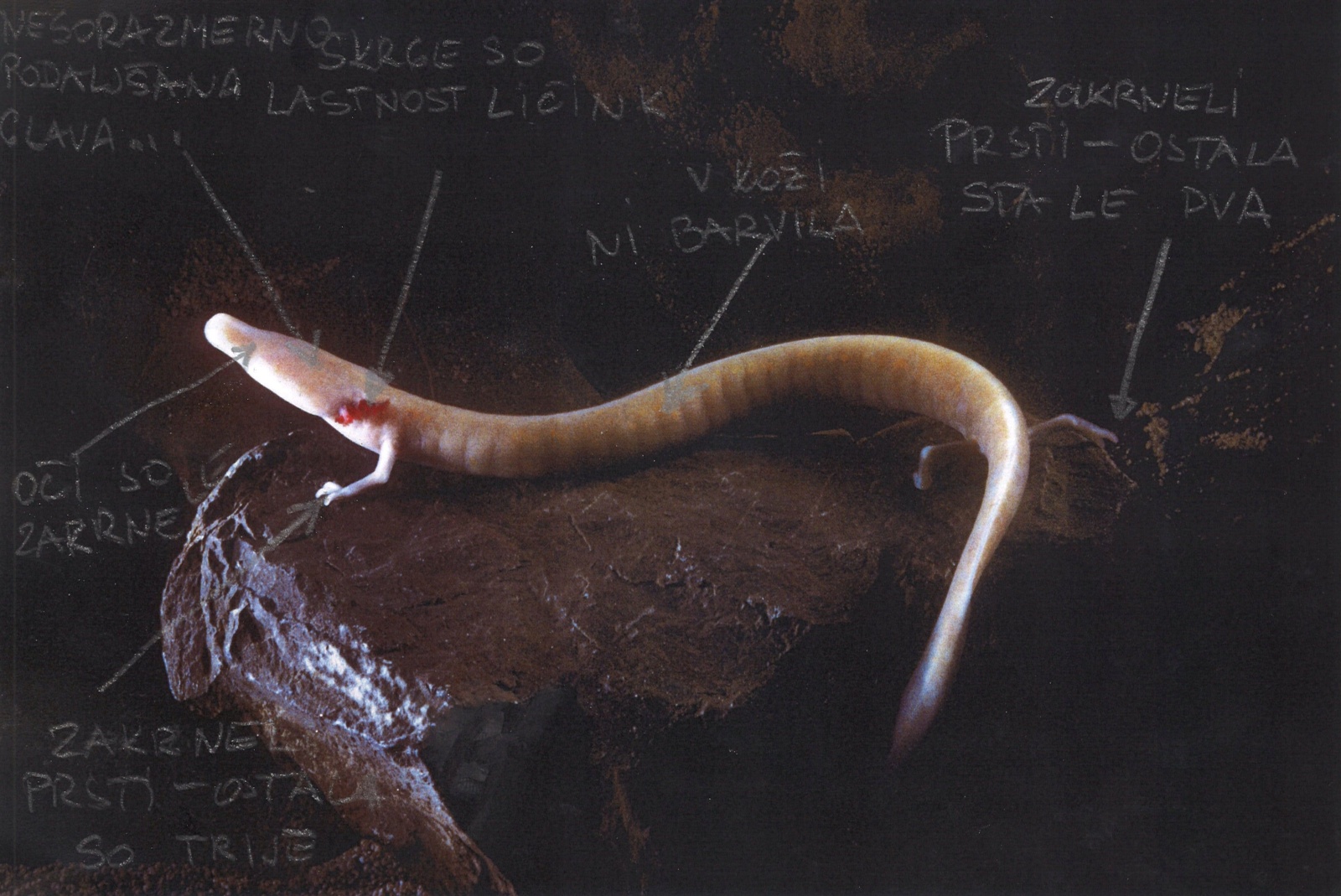Now enter the realistic model of a karst cave. You may notice that the stalactites grow sideways at the entrance to the model. This is the result of a draft carrying drops of water towards the exit of the cave, or algae and lichens growing in the direction of light. In the cave, you can observe the diversity of flowstones: stalactites growing from the ceiling, stalagmites growing from the floor, thin tubular spaghetti resembling stalactites, stalactite columns, calcite crystals, cave pearls and special helictite stalactites growing in all directions. If you don’t recognize them by their name, you can have a look at their photos on the screen at one of the entrances to the cave. But you will no doubt recognize the white olm, a cave salamander also known as a “human fish”, which is well adapted to the cave environment and cannot survive outside caves. Occasionally, some cave guests can be seen here as well, such as bats and certain butterflies, which spend a whole day here and even hibernate. During the day, the barn owl occasionally takes refuge in karst caves, even hundreds of metres deep, where it often nests, too. Now search for traces of the extinct cave bear, which also inhabited our land during the Ice Age. Several of its bones have been found in karst caves, apart from traces of its claws and places where the beast scratched its itchy fur.
Life in Karst Caves
The caves are bound in eternal darkness and typically very humid. There is little food, and the temperature remains virtually constant all year round. Some of its inhabitants have adapted to living in these conditions to such an extent that they cannot survive on the outside at all. These are true cave-dwelling animals or troglobionts. They are either predators or scavengers that feed on the remains of dead plants and animals brought into the cave by water. They are characterised by stunted eyes, lack of pigmentation, well-developed senses of smell and taste, and often elongated legs and antennae. Due to lack of food, they have low metabolism, which results in high longevity and slow reproduction.
Troglobiont, Troglophile or Trogloxene?
All true cave animals (troglobionts), as well as animals adapted to cave conditions (troglophiles), are tiny. Typical representatives include cave snails, crustaceans, arachnids, centipedes and insects. The exception is the olm, which is a real giant among them. Among occasional cave guests (trogloxenes), we find larger species such as bats, martens, mice, dormice, frogs and owls. Animals that are partially adapted to cave conditions and can also survive in similar conditions on the surface are called troglophiles.
The fauna of the Slovenian underground is among the most diverse in the world. There are 400 to 450 different species, of which as many as three hundred are endemic.
The large cave spider (Meta menardi) lives at cave entrances, but can also be found in tunnels, damp cellars, hollow trees etc. Photo: Tomi Trilar
True cave animals are very often endemic – meaning they can only be found in a certain geographically limited area. Anophtalmus hitleri (Hitler’s beetle) was found only in a handful of caves around Celje. Although it is protected, it is hunted illegally by collectors because of its name, which puts it in danger of extinction. Photo: Tomi Trilar
First Cave Animal Discovered
Initial research of life in the underground dates back to 1831, when Luka Čeč, an assistant lamplighter in the Postojna cave discovered a beetle of unusual shape (Leptodirus hochenwartii). He shared his find with the naturalist Count Franz Hochenwart, who sent it to the entomologist Ferdinand J. Schmidt. The latter quickly concluded that it was a cave animal and gave it the scientific classification of a new species. His conclusion meant that animals also lived underground – something scientists did not expect until then. Thus a new branch of biology was born: biospeleology.
Leptodirus hochenwartii’s Slovenian name is “drobnovratnik”, or “one with small neck”, which actually refers to its elongated, narrow chest that resembles a neck.
Dragon Hatchlings
The olm (Proteus anguinus) is first mentioned in Valvasor’s book Glory of the Duchy of Carniola, published in 1689. However, it did not bear that name, nor was anyone aware that it was a cave animal. Rather, it was believed that these small animals, which were brought to the surface by high water, were hatchlings of a dragon that dwelled underground. Today, we know that the olm (also known as proteus or the human fish in Slovene) is an amphibian, just like newts, salamanders and frogs. The larvae of the latter live in water, then, upon metamorphosis into adults, they lose their gills and continue living on land. The olm, on the other hand, spends its entire life in water, matures very slowly and retains its gills even after it grows fully and becomes sexually mature.
Olm’s larvae possess skin pigment and even eyes, but these are later overgrown by skin.
The subspecies of black olm (Proteus anguinus parkelj) was only discovered in 1986. It displays less adaptation to cave environments, retaining eyes in adult form, displaying skin pigmentation, and a head that is less disproportionately elongated compared to its light-coloured relative. It can only be found in a very small area around Črnomelj.
The olm can go up to 12 years without food. It matures sexually after about 14 years and lives up to 100 years.



